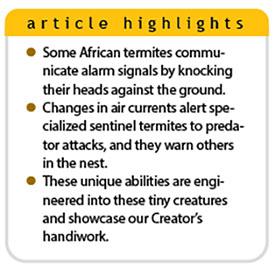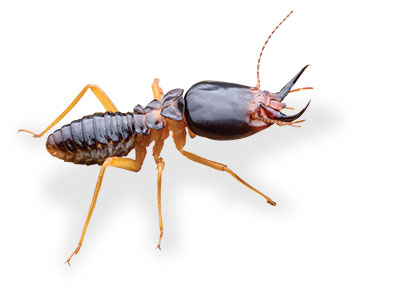 The truth about headbanging termites is both alarming and astonishing. Like other creatures of the world, big and small, headbanging termites (e.g., Macrotermes natalensis) are cleverly constructed to communicate important messages.1,2
The truth about headbanging termites is both alarming and astonishing. Like other creatures of the world, big and small, headbanging termites (e.g., Macrotermes natalensis) are cleverly constructed to communicate important messages.1,2
Who could imagine—much less purposefully invent—an underground warning communication system operated by centimeter-long sentinels who knock their noggins upon the ground repeatedly and rapidly to sound an alarm?2,3 Astonishingly, that auditory-vibrational alarm is relayed from termite to termite in mere seconds, like a chain of signal fires.2,3
Headbanging termites do what is improbable and impossible apart from God. They repeatedly strike their heads against the ground of subterranean “galleries” (ventilated nest-mound chambers and networked tunnels), making a woodpecker-like rapid-drumming series of sounds and vibrations.4
 Fungus-growing higher termites [especially Macrotermes natalensis] build long subterranean galleries that lead outwards from the nest to foraging sites. When soldiers are disturbed, they tend to drum with their heads against the substrate [i.e., floor] and thereby create vibrational alarm signals.2
Fungus-growing higher termites [especially Macrotermes natalensis] build long subterranean galleries that lead outwards from the nest to foraging sites. When soldiers are disturbed, they tend to drum with their heads against the substrate [i.e., floor] and thereby create vibrational alarm signals.2
But why? In Africa’s savannas, even termites have predators. When predatory aardvarks or pangolins (or even ants) break into termite nest-mounds to consume the inhabitants, jeopardized termites need a warning system.2
How will termites know danger has arrived and warn nestmates to flee? Termites live inside gigantic nest-mounds that tower in height compared to the body size of the mound-building termites.4 Predatory “home invasions” often occur with rushes of air currents, so sentinel termites, who continuously track their environmental conditions, react instantly and defensively to sudden air puffs.5 Accordingly, termite researchers used high-speed cameras and audio-recording technology to intrusively squirt puffs of air into termite nest-mound material to trigger and measure sentinel “soldier” termite headbanging.2

Most of us don’t use high-tech equipment to record and analyze the high-speed headbanging of underground termites in Africa. However, we can appreciate how the Lord Jesus Christ providentially planned, programmed, and produced these diminutive detritivores (organic waste eaters)—mostly ignored by us, yet not by Him—as those humble headbanging termites illustrate Christ’s creative imagination and bioengineering.6
Obviously, evolutionary accidents cannot explain, much less invent, such noggin-knocking communicators’ design, development, and deeds. Headbanging termites are alarming, yes, but we can admire their purposeful communications as energetic exhibits of Christ’s glory as Creator.
References
- Animal populations employ diverse communication modes. E.g., see Moon, I. A. 1962. City of the Bees. Chicago, IL: Moody Institute of Science, DVD version 1998. See also Johnson, J. J. S. Jackdaws Identify “Dangerous” from “Safe” Humans. Creation Science Update. Posted on ICR.org May 4, 2020; Johnson, J. J. S. 2020. Sentinels Are Needed in Perilous Times. Acts & Facts. 49 (8): 21.
- “The signals consist of trains of pulses with a pulse repetition rate of 10–20 Hz. The galleries have physical features that promote vibrational communication and are used as channels for long-distance communication. In M. natalensis, the signal propagation velocity is ~130 m s−1 and the signals are attenuated by ~0.4 dB per centimetre distance....Workers respond by a fast retreat into the nest and soldiers are recruited to the source of vibration.” From Hager, F. A. and W. H. Kirchner. 2013. Vibrational Long-Distance Communication in the Termites Macrotermes natalensis and Odontotermes sp. Journal of Experimental Biology. 216 (17): 3249–3256. Pangolins relish ants and termites. See Sherwin, F. The Pangolin: A Mammal with Lizard Scales. Creation Science Update. Posted on ICR.org November 17, 2016.
- Transmitted signals provide coded messages intended to influence message recipients (1 Corinthians 14:8). For ages, humans have used chain-like series of relay signals to rapidly communicate danger/distress across long distances. The practice of relaying a warning by signal fires (relay beacons) is depicted in J. R. R. Tolkien’s Lord of the Rings. In real-world history, Vikings used relay signal fires to communicate impending dangers.
- Termite nest-mounds are admirably ventilated. See Sherwin, F. Termite Nest Architectural Design Is Clearly Seen. Creation Science Update. Posted on ICR.org April 4, 2019. Soldier termites are only ~1 centimeter long, yet their distress signals are quickly transmitted across meters of distance underground to reach other termites. Thus, a termite’s relayed alarm travels a distance 300+ times its own body length. See also Johnson, J. J. S. 2019. Termite Skyscrapers Hidden in Plain View. Acts & Facts. 48 (4): 21.
- “Defending an extended nest system requires a communication system to inform nestmates in remote parts of the gallery about attacks and holes in the nest wall. The use of vibrational alarm signals that can be rapidly transmitted over long distances would allow fast retreat and defence reactions and would clearly be advantageous.” Hager and Kirchner, Vibrational Long-Distance Communication, Journal of Experimental Biology.
- Revelation 4:11. Even “creeping things” glorify their Creator (Psalm 148:7-10).
* Dr. Johnson is Associate Professor of Apologetics and Chief Academic Officer at the Institute for Creation Research.













